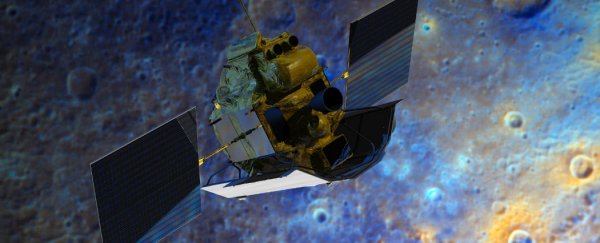Using data obtained from NASA's now defunct MESSENGER spacecraft, scientists have shown that Mercury's magnetic field could be 4 billion years old, outdating Earth's by upwards of 400 million years.
Launched in 2004, the MESSENGER spacecraft reached the orbit of Mercury in 2011 and circled the planet for four years, usually at altitudes of between 500 and 200 km.
After running out of fuel, the spacecraft ended its 11-year mission by crashing into the planet's surface on April 30th.
But for several months before this spectacularly violent finale, the craft was able to orbit closer and closer to the surface, surveying Mercury's rocky ground in unprecedented detail, and providing new insight into the history and evolution of the planet closest to our Sun.
Now, after examining data from a series of these low altitude passes - some as low as 15 km - researchers have been able to detect traces of magnetisation in ancient rocks in the crust, which they say are a telltale sign of a planet-wide magnetic field, nearly 4 billion years old.
"Until this observation all we really knew about the magnetic field's longevity was that it's been around since the first time we were able to observe it, which was with the Mariner 10 mission," planetary geophysicist and lead author Catherine Johnson, from the University of British Columbia in Canada, told Stuart Gary of the ABC.
"So this tells us that there was a field about four billion years ago, and the simplest interpretation of that would be that Mercury has actually had a magnetic field during that whole time."
Evidence of a magnetic field and a large iron-rich core on Mercury was first uncovered by NASA's Mariner 10 spacecraft during its three flybys of the planet in 1974. MESSENGER has now confirmed the presence of this magnetic field.
Generated by the motion of molten liquid deep inside the planet's core - a force known as geodynamo - the magnetic field is similar to that of Earth's, only much weaker. But now, scientists think it could be a few hundred million years older, even though the two planets formed at the same time nearly 4.5 billion years ago.
"In terms of the inner planets of our Solar System, this is the longest lasting geodynamo generated magnetic field that's been observed so far, including the Earth," Johnson told the ABC. "On Earth we have observations of magnetisation of rocks back to about three-and-a-half billion years."
In order to pinpoint the weak magnetic fields present in Mercury's crust, MESSENGER had to ignore magnetic interference from a range of other sources, including the global magnetic field itself, and the interactions between this planet-wide field and the Sun's solar winds, which generate disruptive electromagnetic currents.
The remnant magnetic signatures were detected in two crater-rich regions: the Suisei Planitia, and another area marked by large cliffs, known as Carnegie Rupes.
As Stuart Gary explains for ABC, the researchers "determined the dates of the magnetised rocks on Mercury by first looking at the number of craters in a given area." An area that's more heavily cratered has endured more asteroid and meteor impacts, than other areas, and is therefore older.
The MESSENGER mission, which has already revealed so much about one of our closest neighbours, will likely continue to yield new insights.
"The mission was originally planned to last one year; no one expected it to go for four," Johnson said in a press release. "The science from these recent observations is really interesting and what we've learned about the magnetic field is just the first part of it."
